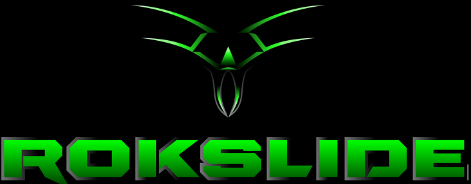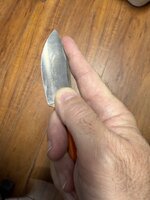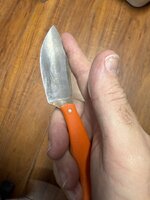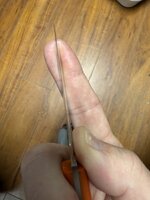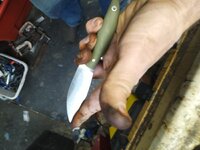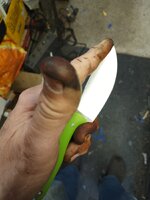A little bit of jumping on the spine near your index finger pad might be a good idea as a frame of reverence for wet hands or awkward positions. I occasionally pull the knife and look at how much tip I have exposed when opening up the belly or working a hind quarter off near the gut so I don't accidentally punch into something unintended.
I have thought about many possibilities, out of the box thinking. This is a creative idea, and one I will keep in mind for future knives that follow a more traditional shape. Because, using “conventional knives”, this is something to consider and always bear in mind—where is the tip.
I have covered this before a little, so bear with me. This conversation is helping me work out words to describe the change in “feel”. Some people might not want to change knives because they are used to the way they do it and don’t care. We aren’t making this knife for them… and that’s OK. I will make more knives in time.
With the Dixie Zipper, you should find that you change the way you have to constantly manipulate and “think about the tip”.
To get everything from this knife, we have to think differently. It’s actually even a little more uncomfortable/awkward to try to keep your finger out to the tip—because the curved spine does the work of your finger.
It’s what I had to constantly fight against, my brain automatically going to how I have held processing knives. It’s muscle memory.
After stumbling on the other thread, the design made me start over. I couldn’t figure out why it was such a weird shape. So, I started not with the knife but my hand and arm. Meaning, I put my hand and arm in positions to cut- and then shaped the handle and angle to me—ergonomics.
You should find it easy to hold the handle or choke up and wield the knife comfortably with one grip for many different tasks.
When it comes to work where we traditionally worried about the tip, the blade design nearly eliminates the worry.
And, the design just works better, it zips under the hide without catching the tip. We who have tested it literally just grab the handle and unzip the hide in one long slice.
If gutting, you will have to pay more attention, but the leaf design does work for you. It’s hard to explain, but the curve on the back pushes the stuff you don’t want to cut away from the tip.
AND; the long curve on the cutting edge effectively means you never run out of blade.
With a traditional knife that has a curved tip and then a straight section, the angle is too shallow on the straight edge, so the knife slips under the hide or belly flesh. That is why you run the knife under and up to the finger guard. You then have to tip the cutting edge at a better angle to cut. But, that then pushes the tip into the meat or guts.
This blade angle/geometry requires the repeated sawing, and the “rythym” of the knife: slip under, push until cutting stops, tilt and pull up, reinsert knife, repeat.
The long curve of the blade means you get cutting action the whole length. And, the curve of the spine keeps the tip from catching by pushing the meat/guts away. It functionally does the same thing as your finger—but better.
When skinning, the blade will zip from end to end in one long motion—without hacking.
When gutting, you may still use your finger, but you don’t need to be right at the tip.
